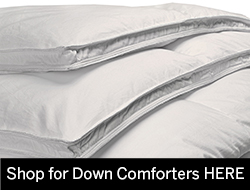Duvet Cover vs. Down Comforter.
We field a lot of questions at Vero Linens and are happy to answer every one of them. One of the more common questions involves the differences and advantages that come with using a down comforter and duvet cover arrangement, as opposed to other top of the bed options. We are confident in saying that duvet covers and comforters have become the most popular top of the bed items in recent years.
Let’s start things off by answering the question, “What is a duvet cover and what is a duvet?”
- The word duvet (pronounced doo-vay) is French for comforter. A duvet is considered to be somewhat synonymous with a down comforter, which can be filled with materials such as wool, silk or polyester.
Nevertheless, a down comforter is also called a duvet. But how can that be?
- A duvet cover is actually a giant pillowcase for your down comforter.
- Most people simply call a duvet cover a duvet. If you want to get technical, this is not accurate. Still, many people refer to it in such a way. But don’t lose any sleep over it as there are greater injustices in the world.
- Duvet covers are usually equipped with a button or zipper closure on the bottom or top of the cover. This is used to prevent the actual comforter from slipping out of the cover.
- We suggest choosing a duvet cover with a hidden button closure because a zipper closures can wind up jamming. The below image shows the underside of a duvet cover.
Do you have to cover a down comforter?
 It is not mandated by any international bedding law, but we recommend doing so. The majority of comforters are made from a white cotton fabric, meaning that they will show signs of discoloration when coming in contact with things like body oil and make-up.
It is not mandated by any international bedding law, but we recommend doing so. The majority of comforters are made from a white cotton fabric, meaning that they will show signs of discoloration when coming in contact with things like body oil and make-up.
- Down comforters are washable, although it is not as simple of a process when compared to washing a duvet cover. Washing your comforter over and over will also impact its life span.
Duvet covers are available in a few different construction styles. There is not a whole lot of variation, although the differences include the following:
- The specific type and placement of a duvet cover’s closure.
- Closures can feature zippers, buttons, ties, or a simple envelope closure.
- Zipper closures may be easy to use, but can get snagged or jammed on loose threads.
- A broken zipper is more difficult to replace than a button.
- Hotels typically use envelope closures because of frequent changing. This is not as convenient in personal bedrooms because comforters can slip out with extended use.
- We recommend using a hidden button closure as pictured above.
There are some manufacturers that place the closure at the top of the duvet cover, which seems a little unusual as it will put the buttons or zipper right in in your face while you sleep. It is much better to have the closure located at the bottom of your duvet cover.
How about the style and construction of the duvet cover?
- There are two types of construction styles: a simple sack or duvet cover made with a flange.
- The simple sack is simply a sack, with its closure located at the foot.
- Flanged construction generally features a decorative flange on three sides of the duvet cover. The flanged cover offers additional length and width, which is key in providing extra coverage to many of today’s super thick mattresses.
- A finished and tailored look is also achieved with the flanged construction.
- Pretty much any fabric can be used in the construction of a duvet cover.
- Our recommendation is to use a washable, sheet-weight fabric, such as cotton.
- There are also duvet covers made from upholstery-grade fabrics. We do not recommend this type of fabric on a duvet cover as it can become very heavy.
- This excess weight makes for an uncomfortable night of sleep and it also drains the air from the down comforter, thus comprising its insulation.
- Additional tip: Since most American homes are furnished with air conditioning, down comforters can be used all year around.
What are the advantages of a duvet cover compared to a regular one-piece construction comforter that has the filling as part of the comforter?
 When a duvet cover is filled with a down comforter, it is very cozy to sleep under.
When a duvet cover is filled with a down comforter, it is very cozy to sleep under.- Duvet covers can be removed very easily from the down comforter.
- Down provides an excellent weight to warmth ratio.
- Cotton duvet covers are much easier to wash than a thick comforter.
- A down comforter will eventually need to be laundered, but washing will be minimized when it is protected by a duvet cover.
Vero Linens is ready to provide you with the luxury bedding that will upgrade every night of sleep. Choose from our large selection of luxury duvet covers, down comforters, feather and down sleeping pillows and much more. Let Vero Linens be your one and only place for luxury linens.
Shop for luxury Italian Duvet Covers below.

